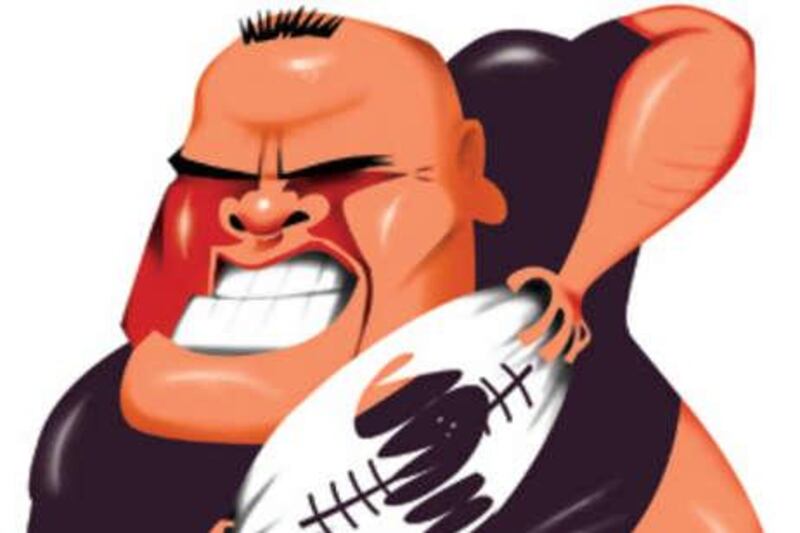Who do you think is sport?s all-time best? Each week, we will profile a candidate, inviting you to decide who should top our list of 50. All participants will be entered into a draw for the weekly adidas prize and an end-of-contest Etihad Holidays four-day trip for two, including business class flights and accommodation, to a mystery location. We will reveal the full 50 at the end, but this week Paul Radley looks at rugby union's Jonah Lomu.
Floating near the top of the library of tribute videos to Jonah Lomu on YouTube is one that is far more telling than any of the compilations of chilling hits or breathtaking tries. In it, Lomu recounts the moment when he was first told he had nephrotic syndrome, a debilitating condition which causes the kidneys to seep large amounts of protein from the blood into the urine. "When I sat down with one of the top kidney specialists, and he turned and said to me, 'You are facing life in a wheelchair,' that was difficult to accept," recalls Lomu.
"If anything, I didn't accept it. I found a power within. In the space of three years, I got out there and played rugby when I shouldn't have. I had to fight for every step to get there." Lomu was already established as "the first global rugby icon" - to borrow a description from another great, the former England captain Martin Johnson - when his story really began. Above rewriting the way the game is played and providing the platform for the move to big money professionalism, Lomu's greatest triumph was his recovery from his kidney disorder to play Test rugby again.
If the battle against the odds is the simplest form of sporting narrative, then Lomu's life provides classic fare. He was brought up by Tongan immigrant parents, Semisi and Hepi Lomu, in Mangere East, one of the toughest suburbs of south Auckland. His devout mother did his best to shield him from strife. As a child, Lomu spent five years back with his extended family in Tonga, while, in his teenage years, Hepi sent him off to the strictly Methodist Wesley College, far enough away from the badlands to give him a start.
Trouble did not ignore Lomu entirely. He was often dragged in to the gang fighting between the rival Polynesians of Mangere East. Horrifically, when he was just 12, his uncle and cousin were murdered in neighbouring Otara. Yet rugby proved his salvation. At 19, the 6ft 5in winger, who had clocked a 100m best of 10.98 seconds, became the youngest ever All Black. By the time of the 1995 World Cup in South Africa, Lomu had become one of the biggest names in all of sport. It was no mean feat, given that his sport was still officially amateur and only really played in the colonies.
He became the perfect embodiment of indestructible youth. Nothing could stop him: not eight French defenders in a World Cup semi-final; not a desperate Stephen Larkham in the final seconds of the greatest Tri-Nations match; not a Mike Catt-shaped road-hump. So sparkling had Lomu's star become, the media magnate Rupert Murdoch had to have him. "He just wanted Jonah on his television screen," revealed one Sky source at the time.
It cost Murdoch a cool £260 million (Dh1.5billion) for the privilege, and southern hemisphere rugby - indeed the game as a whole - changed completely on the back of Lomu's celebrity. Suddenly there was a market for a Tri-Nations tournament, and the first official edition took place in 1996, with Lomu-mania at its height. In keeping with all the best modern sporting icons - Tiger Woods's agent Mark Steinberg defines them, rather soullessly, as "genuine brands" - Lomu's fame transcends rugby.
The game's connoisseurs will claim he could not defend, that he was not as fast as Christian Cullen, or that could not handle the ball like Carlos Spencer. But the All Black jersey is known in rugby outposts like Nairobi, Kuala Lumpur and Bangkok because it was worn by Lomu. He revolutionised the game to such an extent that a glossary of new entries emerged in rugby's lexicon, such as: Freak - Will Carling used it most famously following Lomu's four-try wonder-show against England in the 1995 World Cup semi-final. In truth, it had already been used ad nauseum by beaten opponents in the sevens game, where Lomu initially cut his teeth.
Carling later wrote: "The physical impact that Lomu had on the 1995 World Cup was beyond the effect of any other player in the history of the game. He was so quick, so powerful, so strong that he changed rugby." Thing on the wing - Now used for anyone of a different physique to the prototypical willowy runners who play on the flanks. Elephant gun - As in, "you might stop him with an elephant gun," which was the claim made by the England hooker Brian Moore after the 1995 capitulation.
@Email:pradley@thenational.ae Cast your vote and enter a draw for a weekly Dh500 adidas voucher and a dream trip with Etihad Holidays. If you think Conacher is the all-time best, text G28 to 2337 Texts cost Dh5 and voting will end at midnight on Thursday October 30.






